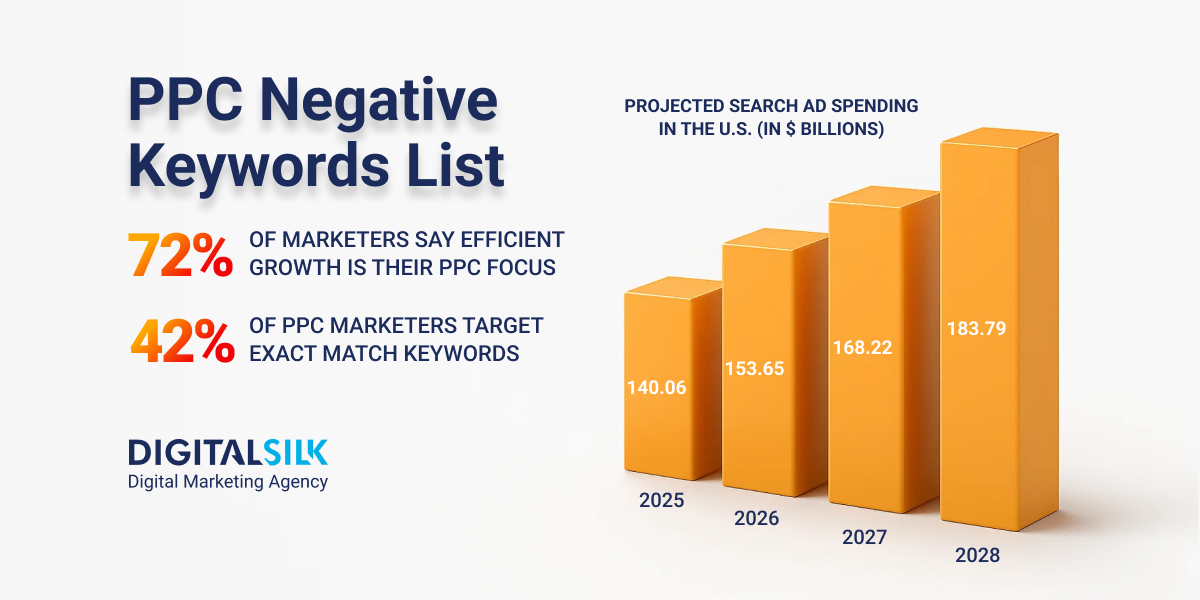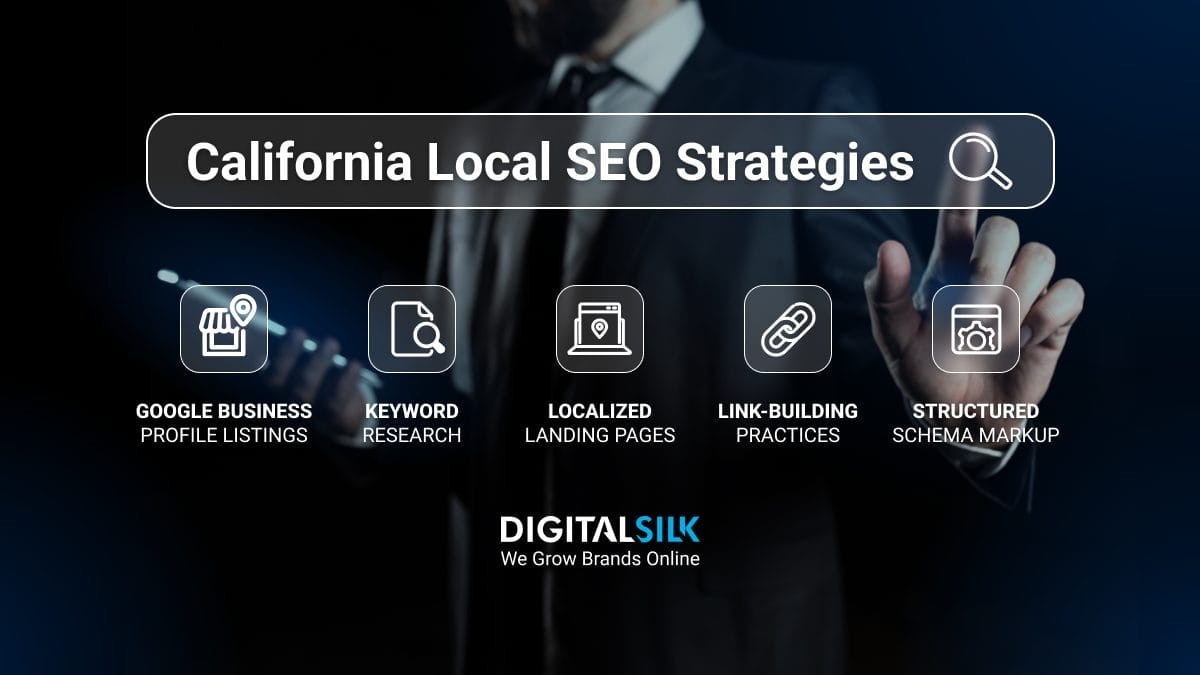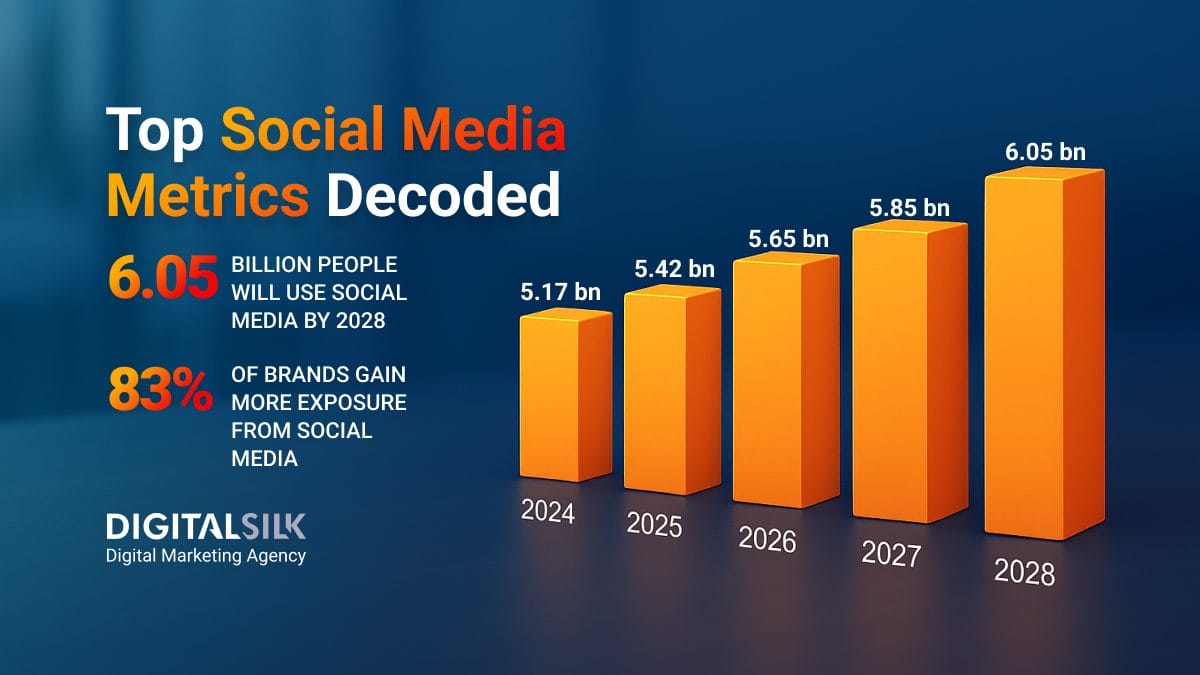PPC Negative Keywords: Key Highlights
-
Irrelevant clicks drain budget: Job seekers, freebie hunters and vague searches quietly burn PPC budget.
-
Weak intent skews results: High CTR hides poor lead quality and drives up acquisition costs.
-
Search precision drives profit: Sharper exclusions lift conversion rates and cut wasted spend.
Search advertising is on a sharp upward trajectory, with U.S. companies expected to invest over $140.06 billion in 2025 alone.
As budgets grow, so does the risk of irrelevant clicks that quietly erode ROI.
If your pay-per-click (PPC) campaigns are costing more but converting less, the issue may lie in who’s seeing your ads and not just how they’re built.
In this blog, we’ll share a comprehensive list of PPC negative keywords to help you cut unnecessary spend, focus on the right audience and surface actionable performance data.
The Complete PPC Negative Keyword List
Google Ads allows up to 20 shared negative keyword lists per account, 5,000 terms per list and 10,000 per campaign, while Display and Video campaigns are limited to 1,000.
This makes it crucial to know how to use negative keywords in PPC to maximize efficiency and targeting.
Below, we’ve compiled examples of negative keywords in PPC campaigns to help you decide what to add and get the most out of each available slot.
1. Universal PPC Negative Keywords
Universal negative keywords are terms that consistently attract low-intent traffic across industries and campaign types.
With 42% of PPC marketers always targeting exact match keywords, refining traffic through strategic exclusions like these helps campaigns stay focused on buyers, not browsers.
Use the following phrases to optimize budget efficiency and deliver better performance:
- Cheap: Encourages more qualified sessions by filtering out users focused solely on low-cost options.
- Directions / Map / Maps: Improves targeting by keeping ads from users who are looking for navigation rather than offers or products.
- Facebook / TikTok / YouTube / Vimeo: Reduces media-driven traffic so campaigns reach users in discovery or purchase mode, not content consumption.
- Sample / Samples / Sampler / Sampling: Shifts attention to paid offerings by excluding queries that signal try-before-you-buy intent.
- Recipe: Keeps campaign focus on product interest rather than content exploration, especially in food or wellness categories.
- Video / Game / Games: Maintains commercial alignment by avoiding traffic from users searching for entertainment instead of products or services.
- Free / No charge / No cost: Prioritizes leads with a transactional mindset, helping protect spend from users expecting zero-cost options.
- Download: Keeps focus on users ready to engage with your offering, not those looking for free files, software or tools.
- Ebay / Craigslist / Udemy: Maintains brand and pricing strategy by excluding third-party platforms that attract bargain hunters or unrelated learning queries.
Pro Tip For Media Teams
Don’t treat universal negatives as a checklist, but more as a filter for intent.
The goal isn’t to block broadly, but to focus precisely, so every exclusion supports your campaign’s positioning, pricing model and audience pain points.
2. eCommerce Industry
U.S. eCommerce revenue is projected to reach $1.88 trillion by 2029 and as more brands compete for the same digital shelf space, intent filtering becomes a direct lever for profitability.
Paid campaigns that don’t actively block low-value queries risk inflated acquisition costs, diluted brand equity and weaker return on ad spend.
eCommerce businesses should focus on the following PPC negative keywords:
- Cheap / Cheapest / Inexpensive / Low price / Low cost: Directs ad spend toward customers who prioritize quality, brand value or product experience rather than price alone.
- Used: Aligns campaigns with buyers looking for new products, which makes budget more effective for full-price inventory.
- Wholesale / Wholesales: Ensures campaigns are focused on end consumers by preventing B2B buying intent from distorting performance.
- Fake / Knockoff: Supports brand trust and authenticity by steering spend toward customers interested in legitimate, quality goods.
- Discount / Discounts / Discount code / Discount codes / Discounted: Maintains alignment between your campaign message and the actual pricing structure on your site.
- Clearance / Clearances / Closeout / Close out / Blowout / Blowouts: Keeps your audience focused on regularly priced merchandise and avoids traffic from deal-only shoppers.
- Free / Trial / Sample: Optimizes for purchase-ready traffic by concentrating on users intending to buy rather than test or browse.
- Bargain / Bargains / Deal / Deals / Deal of the day / Deal of the week: Supports premium or stable pricing strategies by focusing efforts on value-driven buyers instead of flash-sale seekers.
- Review / Forum: Increases conversion potential by prioritizing buyers over users still in research or community discussion phases.
- Repair / DIY: Keeps focus on product buyers rather than hobbyists or those looking to fix existing items.
- Mall / Outlet / Warehouse / Chain / Online / Price: Improves targeting precision by filtering out overly broad or location-driven queries that lack clear purchasing intent.
Pro Tip For eCommerce Teams
Organize these exclusions into thematic groups, such as pricing terms, resale intent, informational queries to simplify testing and campaign scaling.
That structure also makes team-wide audits more actionable and ensures alignment as pricing strategies or product positioning evolve.
3. Legal Services
The legal sector holds the highest average cost-per-click in paid search — $8.94 per click — which means even small volumes of unqualified traffic can lead more wasted marketing budget each month.
While digital marketing strategies for law firms should attract prospective clients, certain broad or informational legal keywords often draw clicks from students, researchers or job seekers — audiences that drive up costs without contributing to case acquisition
Effective PPC advertising negative keywords for the legal industry include:
- Free: Attracts users specifically searching for pro bono legal support, a distinct audience from those seeking paid representation.
- Legal / Law / Laws: Reduces broad, non-specific traffic and keeps campaigns focused on users with intent to hire, not those browsing legal content.
- Lawyer: Targets users who are likely searching for individual attorneys, which can help refine campaigns focused on firm-level services, niche specialties or non-litigation support.
- Act / Act of / Legislation: Keeps ad spend focused on prospective clients by excluding academic, policy and legislative research queries.
- Regulation / Regulations: Avoids non-converting traffic from professionals researching compliance topics unrelated to legal service engagement.
- Compliance: Prevents spend from going toward internal operations or B2B policy research that falls outside your firm’s service offering.
- Lawsuit: Ensures traffic is tied to individuals actively seeking legal help, not general information about litigation or high-profile cases.
Pro Tip For Legal Teams
Fold negative keyword reviews into your intake-marketing sync every quarter.
Legal search volume often fluctuates with regulatory cycles and proactively excluding irrelevant terms helps protect spend and keep your team focused on viable case opportunities.
4. Healthcare Providers
Paid digital advertising receives the largest share of marketing budgets in U.S. healthcare — 12.5% on average — yet much of that spend is lost on irrelevant clicks from users who were never going to convert.
From job seekers and students to self-diagnosers and plan-ineligible patients, poorly filtered traffic can strain both marketing efficiency and operational capacity.
Some of the healthcare PPC campaign negative keywords that narrow your reach to qualified, care-seeking patients include:
- Free / Cheap / Unproven / Newbie: Positions your practice around value and expertise rather than cost-driven or unqualified interest.
- Jobs / Careers / Salaries / Training / Courses / School: Reduces traffic from employment- and education-related searches that compete with patient acquisition goals.
- Symptoms of / Treatment for / Cure for / Is [disease] contagious: Prevents budget from going to informational queries with low intent to schedule care.
- Self-diagnosis / Self-treatment / At-home remedy / Home remedies: Keeps campaigns centered on patients ready to engage with professionals, not manage conditions on their own.
- Mental health / Reproductive health / HIV/AIDS / Cancer: Avoids misaligned impressions when these areas fall outside your treatment scope.
- Surgery / Transplants / Cosmetic procedures: Helps control spend by filtering out queries tied to high-cost procedures you don’t offer.
- Insurance coverage / Medicaid / Medicare: Saves time and budget by avoiding inquiries from users who aren’t covered under your billing policies.
- Lawsuits / Malpractice / Scam / Fraud: Prevents association with legal topics and steers clear of users seeking complaint resolution rather than care.
- Drug names / Prescription terms / Pharmaceutical brands: Keeps campaigns aligned with clinical services instead of pharmacy-related searches.
- Pediatric / Geriatric: Targets spend toward the patient age groups your clinic is actually equipped to treat.
- Pain / Suffering / Discomfort: Reduces vague traffic with low conversion value and unclear intent.
Pro Tip For Healthcare Teams
Use intake feedback and call logs to inform your exclusion strategy. When campaigns are aligned with your clinic’s real capacity and patient profile, marketing spend becomes easier to justify and scale.
5. Education & Online Learning
With 42% of students turning to search engines to explore their study options, paid campaigns are reaching a large audience, but not always a qualified one.
When ad spend is pulled into job seekers, content browsers or mismatched academic interests, the result is lower lead quality and more work for admissions teams.
The PPC negative keyword list below focuses your campaigns on prospective students who are ready to act:
- Jobs / Careers / Faculty positions: Prioritizes student acquisition by reducing traffic from job seekers and academic applicants.
- Free course / Trial class / Sample lesson: Supports paid enrollment models by keeping attention on users who are ready to invest in education.
- Accreditation / Ranking / Reviews: Reduces early-stage traffic from users comparing programs rather than starting an application.
- Workshop / Bootcamp: Keeps campaigns aligned with degree or certificate programs when short-format or skills-based content isn’t part of your offer.
- How to / What is: Removes queries driven by general interest or curiosity, not enrollment intent.
- Class / Classes / Course / Courses: Filters out broad, ambiguous searches that often lack a direct connection to your programs.
- College / Colleges / Local college / State college / Community college / Best college / St college: Helps focus spend on the type of institution and program you actually offer, especially if you’re not targeting public or two-year college applicants.
- University / Universities / School / Schools / Education: Refines targeting when your programs don’t fall under traditional academic categories.
- Learn / Training: Limits traffic from users browsing informal or self-paced learning options.
- Tutorial / Tutorials / Textbook / Textbooks / Books: Ensures spend focuses on prospective students, not those looking for study aids or course materials.
Pro Tip For Admissions Teams
Use your negative keyword strategy to reflect the scope and structure of your programs and branding strategy.
The more precisely you filter out mismatched interest, the more efficiently you’ll convert intent into applications.
6. Financial Services
The financial services sector averages a 3.1% conversion rate — a step above the cross-industry benchmark of 1.7%, but well behind high-performing sectors like legal or industrial.
In a category where trust, intent and qualification matter more than volume, using the right negative keywords is key to making each click count.
You can use these phrases to focus campaigns on qualified prospects, reduce intake noise and improve cost-efficiency across acquisition efforts:
- Jobs / Careers / Analyst roles / Internships: Directs ad spend away from employment traffic and toward decision-makers interested in services, not positions.
- Free account / Demo / Trial: Keeps campaigns aligned with higher-value prospects by filtering out users expecting minimal-commitment or no-cost options.
- What is / Meaning / Definition: Limits spend on early-stage searchers still gathering general knowledge rather than evaluating service providers.
- Student / Personal / DIY: Refines targeting when you’re focused on institutional, commercial or high-net-worth clients, not individual or entry-level segments.
- Credit repair / Bankruptcy: Prevents traffic from users outside your product scope, maintaining a cleaner pipeline for relevant financial services.
Pro Tip For Financial Teams
Use negative keyword trends to reinforce alignment between campaign goals and your highest-value audience segments.
When the right exclusions are in place, conversion rates improve not just in percentage, but in profitability.
7. B2B Industry
In the U.S., 66% of B2B buyers use internet search results to discover new products, while 35% use online advertising to do the same, which presents a real opportunity, but only if your campaigns attract the right kind of attention.
Broad, research-heavy and consumer-focused queries can flood lead funnels with users who browse, compare or read, but have no intent to purchase or initiate contact.
The following examples of negative keywords in PPC campaigns for B2B brands direct spend toward actual buyers and away from informational, low-intent or consumer-aligned traffic:
- Jobs / Hiring / Recruiter / Staffing / Careers / Internships: Helps avoid employment-related queries that can overtake branded and service-specific terms, especially for firms with high visibility.
- Blog / Article / Guide / Report / Research / White paper / Case study: Keeps focus on business buyers rather than passive content consumers.
- Define / Definition / What is / What are / Meaning of / Theory / Theories: Reduces spend on early-stage learning queries that reflect curiosity rather than purchasing intent.
- Consumer / Business to consumer / Business-to-consumer / Personal: Distinguishes B2B targeting from B2C audiences who are unlikely to engage in enterprise-level buying.
- Course / Class / Training / Workshop / Seminar: Filters out educational and development traffic that doesn’t align with product or service demand.
- Example / Sample / Info / FAQ / Learn about / Tutorial: Screens out general-interest or exploratory searches that rarely lead to B2B inquiries.
- News / Newsletter / Magazine / Journal / Wikipedia: Avoids visibility in content-driven searches that lack commercial or transactional relevance.
- Images / Photo / Diagram / Logo / Map / Picture: Reduces impressions from users seeking visuals or assets rather than products or services.
- Book / Books / Store / Stores / Overstock: Protects spend from eCommerce-style or inventory-related traffic, which doesn’t align with enterprise procurement behavior.
Pro Tip For B2B Marketers
Use intent filters to strengthen lead quality at the top of the funnel.
Every excluded term narrows focus toward enterprise-ready buyers and away from the “research and wander” crowd.
Regularly audit search query reports to fine-tune exclusions and keep your lead funnel aligned with actual business intent, not just clicks.
The Importance Of Negative Keywords In PPC Advertising
Understanding the importance of negative keywords in PPC is key to unlocking smarter budget allocation and stronger campaign results.
Negative keywords are one of the few controls in PPC that offer immediate, measurable impact without restructuring your entire digital marketing strategy.
When used well, they sharpen targeting, improve efficiency and free up budget for the clicks that actually matter.
Here’s what thoughtful negative keyword use can do for your campaigns:
- Reduce irrelevant clicks: Keeps your spend away from users who were never going to convert — think job seekers, freebie hunters or general browsers.
- Improve lead quality: Makes it easier for sales teams to engage with prospects who meet your ideal customer profile (ICP) rather than chase down weak or mismatched leads.
- Boost ad relevance and Quality Score: Google rewards focused campaigns — cleaner targeting improves your score, lowers CPC and increases visibility where it counts.
- Increase click-through rate (CTR): Better alignment between search intent and ad copy leads to higher CTR, which is a strong signal of campaign health.
- Lower cost per conversion: With fewer wasted clicks, your budget stretches further and acquisition costs come down.
- Give you better control over spend: Adds precision to budget allocation by removing low-intent or off-topic traffic before it ever reaches the auction.
- Support efficient growth at scale: With 72% of digital advertisers citing efficient growth as their top PPC goal, tightening your negative keyword strategy is a fast way to support that objective without adding more spend.
How To Use Negative Keywords In PPC Advertising
Adding negative keywords is one of the simplest ways to improve PPC performance, but using them correctly takes more than just plugging in a few terms.
Where and how you apply them determines whether you’re fine-tuning targeting or accidentally blocking valuable traffic.
Here’s how to structure your negative keyword strategy across different levels of a PPC account:
- Account-wide exclusions (universal list): Use this level for terms that should never trigger your ads, regardless of campaign or audience — words like jobs, free or DIY, depending on your model. These are your set-it-and-check-it keywords, meant to keep known distractions out of your performance data.
- Campaign-level exclusions: Apply negative keywords here when different campaigns serve distinct audiences, products or services. For example, a company with both B2B and B2C offerings may want to block consumer terms in its enterprise campaigns without affecting its retail ads.
- Ad group-level exclusions: Use this for precision control when campaigns include multiple product lines, personas or funnel stages. This helps you steer traffic to the most relevant ad copy without letting search intent spill into the wrong segment.
Optimize Your PPC Campaigns With Digital Silk
Negative keywords help refine targeting by preventing your ads from appearing for searches that don’t align with your offer.
While they’re often used to block low-value traffic, they also serve as a way to guide budget toward higher-quality clicks.
Adding the right exclusions improves lead quality, sharpens intent signals and gives your team more confidence in the data behind each conversion.
Digital Silk’s experienced marketing specialists rely on the latest best practices and industry insights to build targeted, efficient PPC strategies that prioritize qualified traffic, reduce wasted spend and deliver measurable results.
As a professional digital marketing agency, our services include:
- PPC advertising
- SEO services
- Social media marketing
- Branding services
Let’s create a custom PPC negative keyword list for your campaigns and optimize your spend.
Our experts take full project ownership for each partnership without making you feel like we’re taking over, offer transparent communication at every stage and deliver measurable results.
Contact our team, call us at (800) 206-9413 or fill in the Request a Quote form below to schedule a consultation.
"*" indicates required fields









